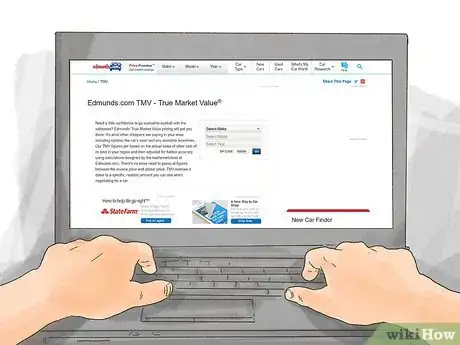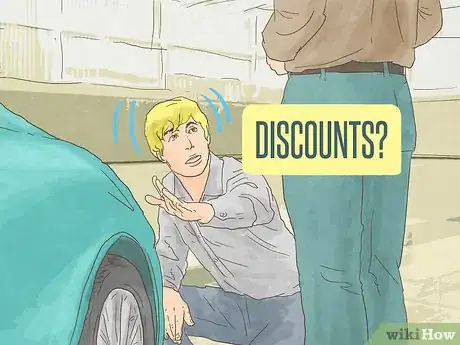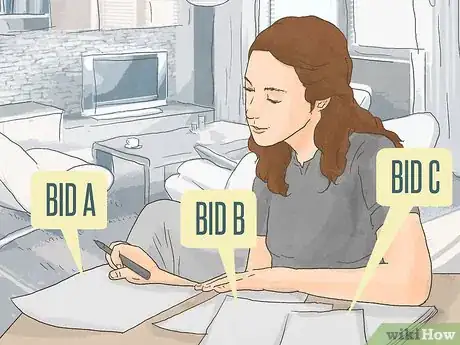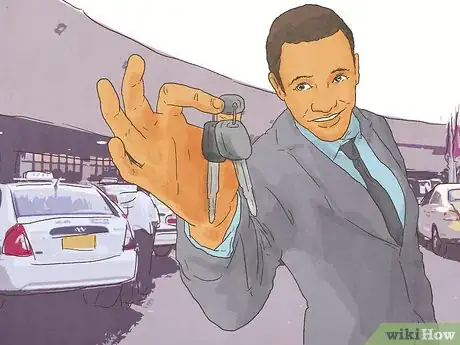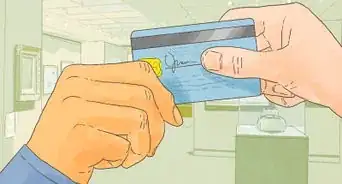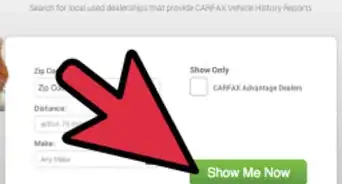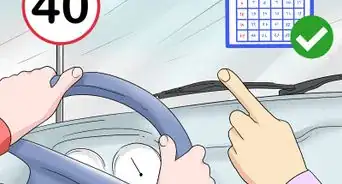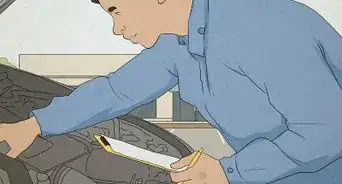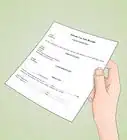This article was co-authored by Bryan Hamby. Bryan Hamby is the owner of Auto Broker Club, a trusted auto brokerage in Los Angeles, California. He founded Auto Broker Club in 2014 out of a passion for cars and a unique talent for customizing the car dealership process to be on the buyer’s side. With 1,400+ deals closed, and a 90% customer retention rate, Bryan’s focus is to simplify the car buying experience through transparency, fair pricing, and world class customer service.
There are 9 references cited in this article, which can be found at the bottom of the page.
This article has been viewed 318,708 times.
If you're buying a new car, you may want to consider going through fleet sales. Fleet sales are aimed at executives, high-rollers, and people buying cars for companies, but many fleet departments will sell to the general public, too. Buying a car through fleet sales minimizes the hassle of buying a car since prices are typically non-negotiable and start at the lowest possible price. Since you're practically buying wholesale, you could a better deal on the car you want.
Steps
Figuring Out Your Automotive Needs
-
1Identify your specifications.[1] The first part of any car-buying process is to figure out what you want in a new car. Consider the color, manufacturer, and options of your car. Some of these might be irrelevant to you, but some might be important. Think about what matters to you in a car and what you'll be doing with your car before deciding which to buy.
- Certain features might depend on your intentions for the car. If you intend to haul lumber in your new vehicle, for instance, you should choose a sturdy pickup truck, not a small compact car.
- If you have several kids you plan on shipping to soccer practice, school, and extracurricular activities, you might want a minivan.
- Decide what parts of your specification are optional or negotiable. If you would prefer slate blue but will consider cobalt or want but don't require a sunroof, write that down, but don't disclose it right away. You can negotiate on these optional points later, if it makes sense to do so.
-
2Decide your budget.[2] How much are you willing to drop on your new car? If you plan on selling your current car, you should include that money in the calculations when setting your budget. Be realistic when setting your budget. Don't buy a car that is not affordable for you.
- You could also think about getting financing for your car. Investigate what kinds of loans you qualify for with your bank or credit union.
- Don't forget to calculate the costs associated with taxes, licensing, and (potentially) interest.
Advertisement -
3Research new cars online.[3] Find a car that meets your specifications. Consider cars that have high standards in safety and overall quality in addition to cars that meet the list of specifications you previously drafted. Check both user reviews and professional reviews written by automobile experts.
- Consumer Reports, Kelly Blue Book, and Auto Trader are useful sources for researching and comparing cars.
-
4Understand the fleet sales pricing process. Typically, the final price of a fleet sales car is between $250 and $1,000 above the invoice price (what the dealership paid for the car). The fleet sales manager may talk about the price of the car you're interested with from this reference point. For instance, if the fleet sales manager tells you a car is “$400 over,” that means it is $400 over the invoice price. A car that was invoiced for $20,000, then, would cost $2,400.
- Each year, most dealerships get anywhere between $200,000 and several million dollars in volume bonuses (rebates given to dealerships when they move a certain number of vehicles). Therefore, their invoice price is not usually a true representation of the cost of the vehicle to the dealership.
-
5Check the sale price of the car you want.[4] Know what the selling price of the car you're interested in is. Knowing the dealer's invoice price and MSRP are the most important things when buying through fleet sales. Most dealerships will not hesitate to give you this information, if you ask. If the price is within your range, proceed with the purchase process. If it is not, find a car that better meets your financial specifications.
- Many online tools will also help you figure out what a reasonable price for a given car is. For instance, the database at http://www.edmunds.com/tmv.html offers both MSRP and actual prices paid on a variety of vehicles.
Communicating With Fleet Sales Departments
-
1Contact local dealerships. It can be a little tricky, however, because retail salesman may attempt to divert your shopping to their own department and might even pretend to be fleet salesmen. For this reason, it's best to identify who the fleet manager of the dealership is before calling the dealership.[5]
- Ask the operator or receptionist for the name of the fleet manager. If you are asked why you wish to know the fleet manager's name, say that you're doing research for your company's upcoming car purchase.
- Be as insistent as you need to be. Once you get the name, ask to speak to the manager and tell him/her that you are interested in buying a car soon. Give a specific time frame (for instance, three days) to show that you're serious.
- Call during regular weekday business hours. Fleet managers and salesmen deal with businesses, which usually operate on that schedule.[6]
- If the manager asks which business you're affiliated with, give the name of the company you work for.[7] Don't lie, however, and say the car is for business use when it's not. Fleet managers are often allowed to sell to private buyers, and if you handle the process professionally, the manager should have no problem doing business with you.
-
2List your requirements.[8] Phone, fax, or email your specification to the fleet departments or managers at several dealers with a request for bids. Again, be sure it gets to the fleet department by using specific names, phone numbers, and e-mail addresses of fleet department managers or salespeople.
- Note on the request for bids that you would like their best price and that you are asking other dealers. This should help shorten the process.
- If you are willing to wait for the car you want to be ordered or transferred from another dealer, state as much on your specification sheet.
-
3Meet with fleet managers. After the various fleet managers get back to you with a bid, make an appointment to meet the ones who have what you're looking for. If all you get is an invitation to come to the dealership without any kind of bid attached, ignore it; they probably don't have what you want and are hoping to convince you to get something else.
- If you receive a bid that doesn't match exactly with your specifications, circle or underline any discrepancies so you can ask about them later.
- If you're not seeing bids that you like, consider expanding your dealership radius, or shopping for a different car.
EXPERT TIPBryan Hamby is the owner of Auto Broker Club, a trusted auto brokerage in Los Angeles, California. He founded Auto Broker Club in 2014 out of a passion for cars and a unique talent for customizing the car dealership process to be on the buyer’s side. With 1,400+ deals closed, and a 90% customer retention rate, Bryan’s focus is to simplify the car buying experience through transparency, fair pricing, and world class customer service.Professional Auto Broker
 Bryan Hamby
Bryan Hamby
Professional Auto BrokerFleet sales typically deal with companies, car brokerages, and organizations. Most people going through fleet sales are buying in bulk for their employees, so true fleet sales departments aren't always willing to negotiate on a single unit. Fleet salespeople are also not usually on the sales floor, but rather in a whole different building from the dealership.
-
4Evaluate the car. Ask to see the car you're considering.[9] Inspect it carefully. Look for dings in the windows, scratches on the surface, flat or low tires, and other imperfections. Pop the trunk and hood and look for anything that could be out of place. Read the window sticker to ensure the model has all the qualities you're looking for. Finally, test drive the car.
- Even if you've test driven that exact model already, sometimes individual cars have manufacturing variations, and it's worth taking a quick spin to make sure everything's in good shape.
- During the test drive, listen for odd sounds coming from the engine, inoperable features like power windows, and other problems.
- Remember, you are about to spend a lot of money and a lot of time in this car, so you should be sure that the car has everything you're looking for.
Purchasing the Car
-
1Inquire about relevant discounts. Ask the dealership to waive the dealer fee if you're buying for a business. Many fleet departments waive these fees without you asking them to do so, but look over the final sale contract to ensure that they do. Ask that manufacturer rebates be factored into the final sales price as well.
- If the fleet sales discounts are incompatible with regular retail sales discounts, ask that the more favorable set of sales discounts be applied to your purchase. For instance, if fleet sales offer cars at the invoice price plus $500, but the dealership is running a sale on that particular car that is lower than the fleet sales price, ask the dealership to sell you the car at the lower retail price.
-
2Look for the best deal.[10] After receiving all the bids from the dealerships you contacted, respond to all the dealerships except the one that offered you the lowest price and ask them if they can beat the lowest bid.
- Next, take your two lowest offers and call the dealership with the higher of the two. Make a firm offer to buy the car at a price that's slightly lower (maybe $200) than the lowest bid; if they say yes, ask them to fax you that bid immediately and make an appointment to fill out the paperwork and buy the car. If they say no, call the dealer with the lowest bid and make an appointment to fill out the paperwork and buy the car.
- Starting this process a week before the end of the month will get you better bids because that's when most dealerships are eager to move inventory.
- Buy under favorable conditions. For instance, you could choose to buy a summer car (a convertible, for instance) during winter. Sometimes a dealership will drop their selling price a few hundred dollars to move a stale car off their lot.
-
3Don't settle for anything less than what you want. Find a dealership that offers exactly what you're looking for.[11] Your area, as far as car dealerships are concerned, should be pretty big. If you can save $500 or $1000 or more by going to another dealership, or get something much closer to what you want, it can be well worth a one-time drive to a dealer a few towns away.
- Wait for the various dealerships to respond with a quotation and compare the offers. Read each offer carefully.
-
4Close the deal. Another unique thing about dealing with fleet sales is that a fleet manager or salesperson can do everything -- sell the car and arrange financing -- without the cryptic consultations between the retail and financing departments that you'd experience otherwise.[12] If you haven't arranged your own financing, the fleet sales department can help you. However, be prepared to make a cash purchase, since many fleet sales departments expect you will.
-
5Apply for a fleet number. If you're buying a number of cars through fleet sales for your business and plan on doing so again in the future, you should get a fleet number. The fleet number will enable you to qualify for deeper discounts than you would as a private purchaser. When you get a fleet number from the automaker, you can use it in future purchases to smooth the transaction.
- Contact the auto manufacturer you're interested in purchasing from in order to apply for a fleet number.
- If you're just buying a private car for yourself through fleet sales, you don't need (and cannot obtain) a fleet number.
Expert Q&A
Did you know you can get expert answers for this article?
Unlock expert answers by supporting wikiHow
-
QuestionIs it a good idea to buy a fleet vehicle?
 Bryan HambyBryan Hamby is the owner of Auto Broker Club, a trusted auto brokerage in Los Angeles, California. He founded Auto Broker Club in 2014 out of a passion for cars and a unique talent for customizing the car dealership process to be on the buyer’s side. With 1,400+ deals closed, and a 90% customer retention rate, Bryan’s focus is to simplify the car buying experience through transparency, fair pricing, and world class customer service.
Bryan HambyBryan Hamby is the owner of Auto Broker Club, a trusted auto brokerage in Los Angeles, California. He founded Auto Broker Club in 2014 out of a passion for cars and a unique talent for customizing the car dealership process to be on the buyer’s side. With 1,400+ deals closed, and a 90% customer retention rate, Bryan’s focus is to simplify the car buying experience through transparency, fair pricing, and world class customer service.
Professional Auto Broker Do your research to identify the fleet manager ahead of time. Fleet sales typically deal with companies, car brokerages, or an organization looking to buy vehicles in bulk. It's common to encounter salespeople at dealerships who call themselves "fleet sales," but they're often just using this label as a marketing strategy to attract customers who think they're getting a better deal. Fleet sales reps are not on the sales floor, and even if you call the company directly, they may put you in touch with the sales rep who responds to internet inquiries, who may not be in fleet sales either.
Do your research to identify the fleet manager ahead of time. Fleet sales typically deal with companies, car brokerages, or an organization looking to buy vehicles in bulk. It's common to encounter salespeople at dealerships who call themselves "fleet sales," but they're often just using this label as a marketing strategy to attract customers who think they're getting a better deal. Fleet sales reps are not on the sales floor, and even if you call the company directly, they may put you in touch with the sales rep who responds to internet inquiries, who may not be in fleet sales either. -
QuestionDoes the vehicle have to be new, or can I buy a used van for my business?
 Community AnswerOnly new cars and trucks fall under "Fleet" programs, as they use discounts provided by the manufacturer (not the local dealer).
Community AnswerOnly new cars and trucks fall under "Fleet" programs, as they use discounts provided by the manufacturer (not the local dealer). -
QuestionCan I buy a Honda Fit through fleet sales?
 Community AnswerYou may be able to buy a Honda Fleet through fleet sales. Contact your local Honda dealership for details.
Community AnswerYou may be able to buy a Honda Fleet through fleet sales. Contact your local Honda dealership for details.
Warnings
- Always negotiate on price, never on monthly payment. When you get a price that you want, figure out the cost over the life of whatever loan you will have, and understand exactly how much you are paying to borrow the money for your car.⧼thumbs_response⧽
- Don't rush into a car purchase. Take your time and evaluate all your options.⧼thumbs_response⧽
References
- ↑ https://www.kbb.com/car-news/10-tips-for-first_time-car-buyers/
- ↑ https://www.kbb.com/car-news/10-tips-for-first_time-car-buyers/
- ↑ https://www.kbb.com/car-news/10-tips-for-first_time-car-buyers/
- ↑ https://www.kbb.com/car-news/10-tips-for-first_time-car-buyers/
- ↑ http://beatthecarsalesman.com/secret-fleet.html
- ↑ https://www.entrepreneur.com/article/220323
- ↑ http://beatthecarsalesman.com/secret-fleet.html
- ↑ https://www.entrepreneur.com/article/220323
- ↑ http://beatthecarsalesman.com/secret-fleet.html
About This Article
Many car dealers have fleet departments where you can get an extra discount on your new vehicle. To find the best deal, call different dealerships in your area and ask to speak to their fleet managers. Then, ask them for quotes for the car you’re interested in. Dealers will usually charge you the invoice price of the car plus their own seller fee. For example, they might quote you “$400 over the invoice price.” Once you’ve got a few quotes, make an appointment with the dealer who offered you the best price. If you're buying the car for personal use, you'll probably have to pay the dealer fee. If you’re buying it for business, they should automatically waive the fee, but if they don’t, ask them to waive it. For more tips from our Car Dealer co-author, including how to buy multiple cars through fleet sales, read on!




